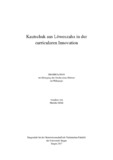Citation link:
https://nbn-resolving.org/urn:nbn:de:hbz:467-13224Files in This Item:
| File | Description | Size | Format | |
|---|---|---|---|---|
| Dissertation_Mareike_Goebel.pdf | 8.66 MB | Adobe PDF |  View/Open |
| Dokument Type: | Doctoral Thesis | metadata.dc.title: | Kautschuk aus Löwenzahn in der curricularen Innovation | Other Titles: | Rubber from dandelion in curricular innovation research | Authors: | Göbel, Mareike | Institute: | Fakultät IV - Naturwissenschaftlich-Technische Fakultät | Free keywords: | Taraxacum kok-saghyz, Curriculare Innovation, Curriculare Innovationsforschung, Schülerlabor, Schülerexperiment, Chemistry, Experiment, Natural rubber, Russian dandelion | Dewey Decimal Classification: | 370 Erziehung, Schul- und Bildungswesen | GHBS-Clases: | IIA UYM |
Issue Date: | 2017 | Publish Date: | 2018 | Abstract: | Der Löwenzahn ist eine weit verbreitete und wohlbekannte, aber auch unterschätzte Pflanze. In neueren Forschungsprojekten untersucht man intensiv die russische Löwenzahnart Taraxacum kok-saghyz, die in ihren Wurzeln Kautschuk von hoher Qualität führt. Dort findet sich auch das Reservekohlenhydrat Inulin, welches als Ballaststoff und Zucker- sowie Fettaustauschstoff eingesetzt werden kann. Der aus Taraxacum kok-saghyz isolierbare Kautschuk soll zukünftig in der Reifenherstellung und Automobilindustrie Anwendung finden; für das Inulin interessiert sich vor allem die Lebensmittelindustrie. Aktualität, Relevanz und Bedeutung dieser Forschungs- und Entwicklungsarbeiten für die Zukunft machen die Thematik auch als Unterrichtsinhalt für den Chemieunterricht interessant. In diesem Sinne wird das Thema im Rahmen dieser Arbeit nach dem Ansatz der curricularen Innovationsforschung für den Chemieunterricht aufbereitet. Dazu wurden zunächst Experimente entwickelt, mit denen es Lernenden möglich ist, Kautschuk und Inulin selbstständig aus den Wurzeln des russischen Löwenzahns zu gewinnen und die Produkte im Experiment sowie mit modernen Analysemethoden nachzuweisen. Davon ausgehend wurden Unterrichtsmaterialien entwickelt, die aktuellen fachdidaktischen Herausforderungen wie einer Bildung für nachhaltige Entwicklung, Relevanz und Gesellschaftsbezug sowie Einbezug von NOS (nature of science) gerecht werden. Zur Sicherung der Durchführbarkeit und schulischen Eignung wurden die entwickelten Experimente und Unterrichtsmaterialien im Rahmen von Projekttagen mit Oberstufenkursen erprobt. Dabei wurde auch eine Erhebung zum aktuellen Interesse der teilnehmenden Lernenden an Tätigkeiten im und Inhalten des Projektes durchgeführt. Die Ergebnisse deuten darauf hin, dass die experimentelle Beschäftigung mit Kautschuk den Lernenden Freude bereitet und ihr aktuelles Interesse weckt. Dandelion is a widespread and well known but also rather underestimated plant. In current research projects, the Russian species of dandelion Taraxacum kok-saghyz is investigated. The plant contains high-quality rubber in its roots and also the carbohydrate inulin, which is not only a dietary fibre but can also be used as a substitute for fat and sugar. In the future, it is planned to use the isolated rubber from Taraxacum kok-saghyz for tyre production and in the car industry; the inulin is of special interest for the food industry. Topicality, relevance and significance of these research and development projects also make the topic interesting for chemistry lessons in school. With this in mind, the topic is edited following the approach of curricular innovation research for chemistry classes. For this purpose, experiments were developed to enable students to extract rubber and inulin independently and subsequently detect the products in experiments and by using modern methods of analysis. On that basis, teaching materials and a concept for chemistry classes were developed that meet the requirements of recently discussed challenges in chemistry didactics such as an education for sustainable development (ESD), relevance, societal dimension and nature of science (NOS). The feasibility and practicability of the developed experiments and teaching materials were tested with students of grade 10 to 13 (“Oberstufe”). A survey to evaluate the actual interest of the participants in activities and contents of the projects was made. The results indicate that experimenting with rubber gives the students pleasure and arouses their actual interest. |
URN: | urn:nbn:de:hbz:467-13224 | URI: | https://dspace.ub.uni-siegen.de/handle/ubsi/1322 | License: | https://dspace.ub.uni-siegen.de/static/license.txt |
| Appears in Collections: | Hochschulschriften |
This item is protected by original copyright |
Page view(s)
1,624
checked on Jan 15, 2025
Download(s)
2,008
checked on Jan 15, 2025
Google ScholarTM
Check
Items in DSpace are protected by copyright, with all rights reserved, unless otherwise indicated.

